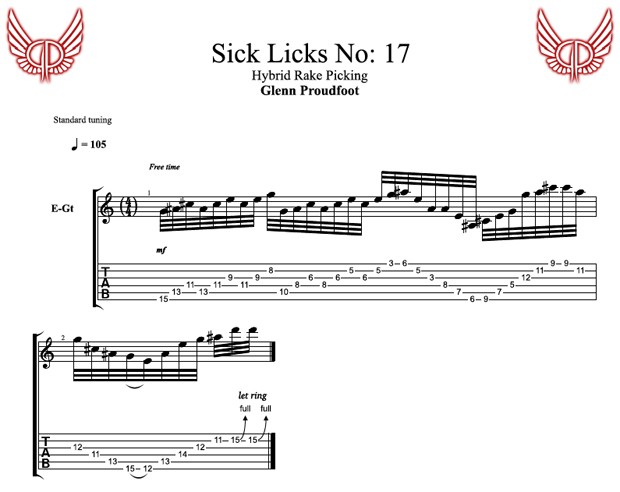Sick Licks: Hybrid Rake Picking Inspired by Shawn Lane

The first time I came across this style of picking was in an article by guitarist Shawn Lane.
I was totally blown away by his use of the traditional sweep picking while combining the use of his right-hand fingers to pick notes within the arpeggios. This technique works particularly well with major/minor scales or modal playing, as it is very easy to create three-string shapes that flow very nicely and closely together. But for this example, I'm using the Diminished 7th scale as it is very easily adaptable to rock and metal soloing.
But like with any of these licks and ideas, it's important to adapt them to as many different scales as possible. Just find a way to incorporate this idea into your playing; it doesn’t necessarily have to be the lick I've played here — just work up your own interpretation.
This is a technique most country and bluegrass guitarists do if they use a flat pick, but the interesting thing is that Shawn adapted this kind of technique to modern electric soloing. When adapted to three-string arpeggios, this lets you create triplet feels and generally have more control of the timing of the arpeggios. As you know, it is sometimes difficult to control the rhythm of the lick when you just sweep the patterns as we are simply dragging the pick across the strings. With this technique, we immediately gain more control rhythmically.
The principle of this lick is simple, we sweep the first two notes with a down stroke, then with our right middle finger we pluck the third note with an upstroke. We continue this same process with every three-string arpeggio we play.
I start this lick on the 15th fret of the low E string. From here I start moving down the neck with three-string arpeggios using the “Rake Technique." There are six three-string arpeggio’s in this first passage, all using the Diminished 7th scale. I suggest breaking this down into groups of three, so practice the first three arpeggios separately, then the next three. From there, put them all together.
Like I've said many times before, it's much better to break things down and get used to the technique and build some speed in one position before moving on. This will boost your confidence and help you master the technique quicker.
The next section is where I play three six-string arpeggios (one note per string). The first arpeggio is played forwards, and the second and third are backwards. This is a really cool way of moving up and down the neck and keeping listeners on their toes! This is all swept with one constant motion. Once again, just practice this at a very slow pace making sure you're creating a smooth, natural flow with the fingerings and the notes. Then slowly bring it up to speed.
I finish this lick with a five-string arpeggio leading into a bend.
This technique, like all the techniques I share, can be adapted to all scales. I simply show these examples in what I believe to be the most adaptable form for rock and metal soloing in the hope that you can put them to use sooner!
Practice hard and I hope you enjoy!
Thanks, and I hope you enjoy! Please join me on YouTube here.

Australia's Glenn Proudfoot has played and toured with major signed bands and artists in Europe and Australia, including progressive rockers Prazsky Vyber. Glenn released his first instrumental solo album, Lick Em, in 2010. It is available on iTunes and at glennproudfoot.com. Glenn was featured in the October 2010 issue of Guitar World and now creates "Betcha Can’t Play This" segments and lessons for GW. Glenn also has a monthly GW column, "Loud & Proud," which offers insight into his style and approach to the guitar. Glenn is working on a project with Ezekiel Ox (ex Mammal) and Lucius Borich (Cog), which is managed by Ted Gardner, ex-Tool and Jane's Addiction manager. The band has done pre-production on 22 tracks and is set to hit the studio and finish their first studio album. The album is set for release in 2012. Glenn also is working on the followup to his debut album; it, too, will be released in 2012.
Get The Pick Newsletter
All the latest guitar news, interviews, lessons, reviews, deals and more, direct to your inbox!









![Joe Bonamassa [left] wears a deep blue suit and polka-dotted shirt and plays his green refin Strat; the late Irish blues legend Rory Gallagher [right] screams and inflicts some punishment on his heavily worn number one Stratocaster.](https://cdn.mos.cms.futurecdn.net/cw28h7UBcTVfTLs7p7eiLe.jpg)
